Its surreal, almost irreverent, to be writing about travel at this time. And hard to believe that I was on the road only about a month ago. When I flew out at the end of February, there were no travel restrictions in place, and not a single confirmed case in all of NYC. When I returned on the 10th of March – to absolutely zero checks at JFK – confirmed cases in the area were in the double digits. From the 13th, we began working from home, in what was then only deemed a precautionary measure. The words lockdown and social-distancing had yet to make inroads in our collective lexicon.
For the few of us who made this trip – despite being warned by friends and family – it was a calculated risk all along, or so we thought. Not in our wildest imagination did we consider a scenario as dire as the one we’re all living through today. We were all incredibly lucky, in hindsight, to go through with our itinerary as planned, and return to our respective cities unscathed.
This is, no doubt, my last post for a while, but I eagerly look forward to the day when the world goes back to being the open and welcoming place its meant to be, and we can all make travel plans with confidence once again. Till then, I remain immensely grateful for the privilege accorded to me last month, and to be able to share those memories with all of you today.
The Wat of all things
When I visited over a decade ago, Bangkok made a great first impression on me. For a city lover like myself, it had all the ingredients of a great metropolis. But I barely did the city any justice. This time around, knowing I’d be strapped for time, I made it a point to at least visit some of its main attractions – Temples, or Wat‘s as they’re known locally. Ranging from unsung little shrines to imposing stupas and grand pavilions, the city is dotted with them. Thai temple architecture draws from several other styles, but stands out confidently on its own, providing incredible juxtaposition, and a sense of balance, to the Capital’s more contemporary skyline. From the giant gilded statue at Wat Pho, to the demon guardians of Wat Phra Kaew, to the porcelain mosaics at Wat Arun, Bangkok’s temples are incredibly easy on the eyes.

Gridlocked no more
The city might be synonymous with its traffic bottlenecks, but getting around can be stress free, and often times, pleasant too. If the Skytrain or Metro don’t quite reach where you want to go, chances are there’s a commuter ferry or a cross river boat on the Chao Phraya that will do the needful. Or a Khlong plying one of the Capital’s hidden but utterly charming canals, providing you with a completely distinct view of the city, and very often, the fastest commuting alternative too. All for a song.
The Eastern & Oriental
On arrival at Singapore by train from Kuala Lumpur more than a decade ago, I had seen the storied luxury train depart on its 3N / 4D itinerary to Bangkok. It was a sight for sore eyes. I happened to check its March schedule just before flying out of New York, and sure enough, the first departure of the month from Bangkok was the very day I was landing there. Singapore’s storied Keppel Road Station has ceased to exist as a terminal since, as will, sadly, Bangkok’s majestic Hua Lamphong Station later this year. So I couldn’t let that moment pass. Someday, of course, I hope to ride it, but for now, every chance encounter with the Eastern & Oriental Express has been worth it.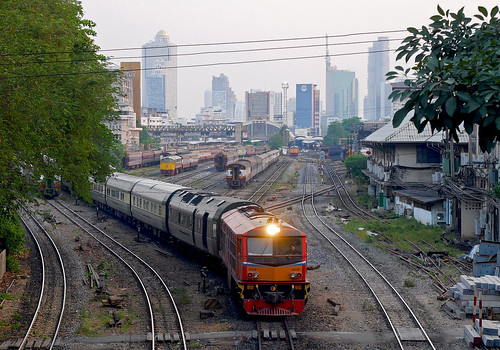
Epicurean delight
There is every bias in what I am about to say since Thai cuisine has, for the longest time, been one of my favorites. Even so, every meal I ate – from the little street shack in Kanchanaburi, to flimsy plastic container meals sold onboard trains, to chic open kitchens in a glitzy Bangkok mall – were consistently excellent. They didn’t so much as make a dent on my wallet, nor come at any expense to my stomach – testament, if we ever needed one, to just how great the food culture is in Thailand. But the most memorable of them all was the one my sister and I had at S’uvimol Tea House in the Thung Maha Mek neighborhood of Bangkok, where ambiance, presentation and flavor came together in one exquisite symphony.
Bridge on the River Kwai
David Lean’s namesake film was actually shot in Sri Lanka, and the river itself wasn’t referred to as the Kwai till the 60s. Regardless, the bridge in question is legit; still operational to this day, and has been on my bucket list for as long as I’ve known about it. If time permitted, I would’ve traveled all the way to Nam Tok, but I had to make do with detraining at the River Kwai Bridge Station, watching my train continue across it, and eventually walking the length of the legendary structure. All of which, of course, was immensely gratifying. Someday, I’ll make it to the end of the line.
Death Railway
Close to thirteen thousand POWs died during the construction of the Siam – Burma Railway, a figure that quickly earned the railway its notorious nickname. With a few hours to spare in Kanchanaburi before catching my train back to Bangkok, I was eager to pay my respects at the war cemetery, as also visit the nearby Death Railway Museum. The overly enthusiastic boatman, who I hired to ferry me a few miles downstream of the Khwae Yai, set me down a lot further, which kind of worked out, as I got an unplanned excursion through the town of Kanchanaburi. Run by the Commonwealth War Graves Commission, the Don-Rak War Cemetery – one of two in Kanchanaburi – is an impeccably kept burial ground, and the compact but incredibly informative museum across from it, helps tie it all together succinctly. As you’d expect, its all very sobering, so plan for a chilled one right after.
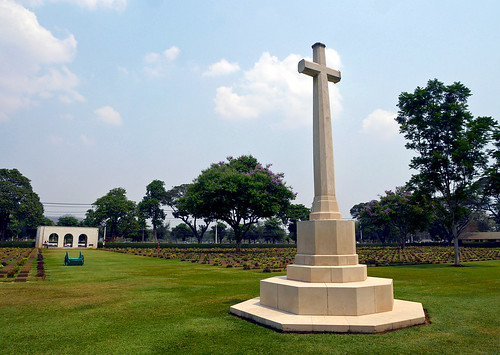
The slow route to Siem Reap
There’s an inexplicable joy I derive from international border crossings by land. Something about them that adds a sense of purpose to the simple act of arriving at your destination. Even more so if its done by rail. So, with an unsuspecting cousin in tow, determined to squeeze in as much train travel as was logistically feasible on this trip, I took the all-stops passenger from Bangkok to the Thai border town of Aranyaprathet, then a taxi from there to Siem Reap. If the two countries can get their act together someday, through trains would be able to run between Bangkok and Phnom Penh, with passengers clearing border formalities at the newly commissioned border station of Ban Klong Luk. But for now, one has to leave the train there, clear Thai customs, then walk across the “Friendship Bridge” into the chaos of Poi Pet, fending off touts and travel agents as you make your way into Cambodia. Cost of train ticket, $1.50. Cost of shared taxi, negotiable. Adventure? Guaranteed.

Succor at the Rambutan
All told, that journey took almost nine hours door to door, so I was tired, sweaty and hungry by the time I made it to Siem Reap. I couldn’t have asked for anything more pleasant and welcoming though, than the tropical little oasis that is the Rambutan Boutique Hotel. Nestled at the very end of a cul-de-sac, on the east side of the Siem Reap River, its one of those rare properties that turns out to be a lot better in reality than in any photograph or publicity material you’ve seen. The balm that I sorely needed.

Phearum, man of the hour
One can go about exploring the ruins at Angkor in a handful of ways. There are fully curated experiences to choose from, either by minivan or jeep, dependent on your group size, or for the more hardy amongst us, even by bicycle. For something more relaxed and fun, there’s nothing better than simply hiring a Tuk Tuk for the day. Essentially two-wheeled carriages pulled by motorbikes, Cambodian Tuk Tuks differ significantly from their Thai counterparts, and are every bit worth the experience. We were fortunate to be paired with Phearum, who’s ever-smiling persona and relentless enthusiasm ensured we had a productive, and most memorable day in Angkor.
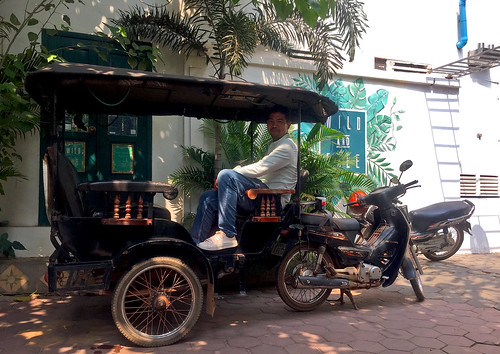
City of Temples
Surrounded by a moat some 5-km (3-miles) in length, the richly carved prangs or towers that define Angkor Wat beckon from a distance. Wat means temple and Angkor translates to City or Capital, and given its humongous 400-acre footprint, Ankgor Wat is precisely that – a City of Temples. Built by the Khmer Empire in the early twelfth, as a Hindu Temple dedicated to Vishnu, it was repurposed as a Buddhist center of worship by the end of that century. Apart from its sheer sprawl and obvious architectural allure, Angkor Wat is probably best known for its stunning bas-reliefs, depicting, amongst other mythical tales, the great Hindu epics, in painstaking detail. Considered the world’s largest religious monument, Angkor Wat is also the best preserved of the many temple sites that make up Angkor Archeological Park, and fascinatingly, the only one amongst them facing west. So vast and engrossing is the temple complex that you could easily spend an entire day there and barely do it any justice.


All roads lead to Bayon
Established in the late 12th-century, Angkor Thom, literally “Great City”, was the last of the Khmer Capitals to be built, and a well planned one at that. Protected by a defensive wall, complete with a moat or baray, and a grand entranceway guarding each of its cardinal points, the city was inhabited till the early 17th-century. Much of the wall, and all of the gates still stand to this day, and as they did back then, all roads continue to lead to the Bayon, at the very center of the erstwhile city. The Khmers, deeply entrenched in Buddhism by then, built the Bayon as their state temple, serving the Mahayana, and later, Theravada school of Buddhism. Appearing from afar like a jumbled cluster of hastily put together sandstone blocks, the Bayon gradually reveals itself to be an extraordinary bit of workmanship – the serene face of the Buddha carved into over two hundred giant stones, topping off the many towers that make up the temple complex.

Lara Croft was here
Of the many sites within the Angkor Archeological Park, one of the most visited, and probably its most photographed is Ta Prohm. Made famous almost two decades ago by the Hollywood production, Lara Croft: Tomb Raider, the temple is the only one standing much in the same condition in which it was found. Over the last decade, the Archeological Survey of India has taken on the onus of restoration, but the very essence of the site will remain – its dense jungle setting for one, and the gigantic trees growing out of its ruins. Angkor scholar Maurice Glaize described it best, “…in fantastic over-scale, the trunks of the silk-cotton trees soar skywards under a shadowy green canopy, their long spreading skirts trailing the ground and their endless roots coiling more like reptiles than plants.” Its a sight to savor at all times, even more so if you get there close to sundown.

Hideaway at Long Beach
Back in Thailand, with our urban and cultural appetites well satiated, we headed south to the island of Koh Lanta, one of many that dot the Andaman Sea, off the southwestern coast of the country. Sufficiently set back from the islands main north-south artery, Eco Lanta Hideaway Beach Resort certainly lived up to its hideaway tag, and we got there just in time for a late lunch. Behind us, the peaceful, sylvan setting of our resort, made up entirely of independent Thai-style bungalows, and in front, the lazy, late afternoon vibe on Long Beach. After a marathon bit of traveling – yet again – it was precisely what the doctor ordered.

Isle of Lanta
On our first full day on the island, while my sister chose to slog it out at the resort, I had a laundry list worth of items to get through. A National Park to visit, random beaches to stop at, the occasional beverage to imbibe, and so on. And a chance to do all that while overcoming my fear on a motorized two-wheeler. The one and only time I had commandeered a scooter or moped also happened to be in Thailand, back in 2004. And if memory serves, that didn’t end particularly well – for the vehicle in question or me. But I might have finally got the hang of it in Koh Lanta. And it certainly helped that the idyllic roads – of which the island boasts a grand total of two – had negligible traffic aside from other two-wheelers. The pit stops played their part too. A Chang here, a mini hike there, some Mango Sticky Rice, and plenty of sandy interludes.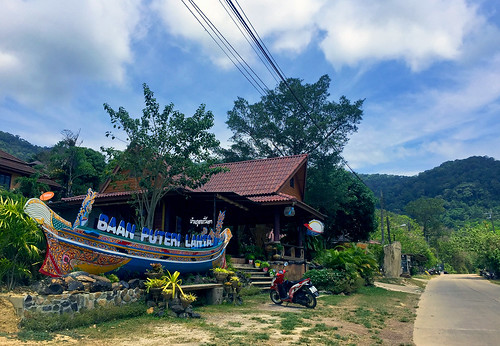

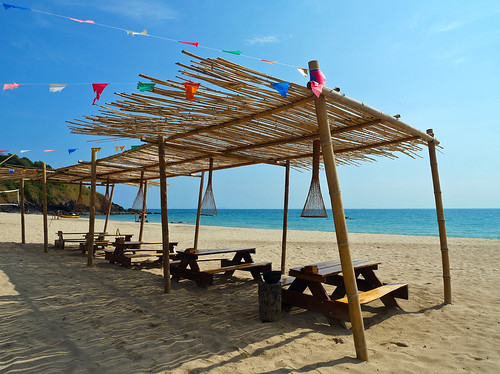
The Old Town
My last stop for the day was Lanta Old Town. Located on the southeast of the island, its the only other population center of note in Koh Lanta, the other being Saladan, on the islands north. A fishing hamlet essentially, its notable for its collection of traditional wooden houses on stilts, as also the 3-day long Lanta Lanta Festival that it hosts in March every year, in conjunction with the full moon – one that I just chanced upon. There were food stalls everywhere; artisans selling their wares, stages set up for musical performances, and out on the water, colorful flotillas in formation. At Shine-Talay Restaurant, just off the main drag, I sat out on the deck and took it all in; an easily grammable, and thoroughly refreshing glass of fresh Passion Fruit Juice by my side.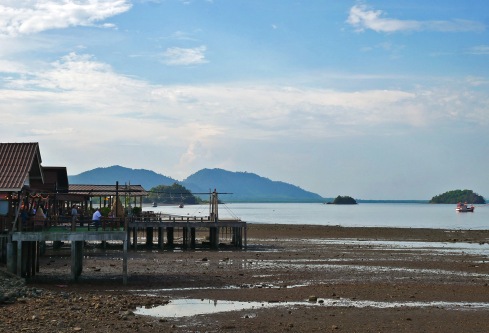

Chasing sunsets
My late afternoon nap the day prior turned into quite the slumber and I slept right through sunset. A pity really, since Long Beach faces west and our resort had a ringside view to the evening spectacle. So, not wanting to miss the action on our final evening on the island, I was eager to get back in time for sundown, and avail happy hour while I was at it. But the drive back from Lanta Old Town to Long Beach had other plans in store for me. The skies had cleared dramatically following a passing shower, and as the day inched closer towards sunset, the light was just too magical to ignore – I couldn’t help but make frequent stops along the way. In my final push to get back to the hotel, I overshot the property entirely! But make it to Long Beach, I did, with about a minute to spare. And what a performance it was…

Long-tail to Railay
Nestled between dramatic limestone cliffs, Railay or Rai Leh, is one of Krabi‘s best known beaches. For years, the towering escarpments that surround it have attracted climbers from all over the world, but have also prevented access from the mainland to the coveted strip of sand. Getting to Railay, therefore, is half the adventure. It requires hopping on one of the many boats that ply between the shores of Ao Nang and Railay, in what could only be described as an exhilarating ride. The boats in question are the legendary Long-tails (Ruea Hang Yao in Thai), which have tirelessly ferried sun-seekers back and forth over the decades. Powered by a second-hand car or truck engine, the driveshafts on these boats are extended by several meters to properly align the propeller, giving the boats their name and distinct appearance. Fifteen minutes is all takes to reach Railay, but its a boat ride for the ages.

Same same but different
Ubiquitous across the country, night markets are an integral part of the food culture in Thailand. Bangkok has over a dozen of them, and those are just the known ones. A town the size of Krabi has a handful to its credit. They’re essentially the same concept wherever you go – food and shopping, late into the night – but each has something unique to offer. In Krabi, for instance, given its large Muslim population, you’ll see more of a Malay-influence in the food than you’re likely to find elsewhere. So I was sure, even before I got to Krabi, how I wanted to spend the evening there – in one of its bustling night markets. Bamboo Cocktails? Solid start. Thai-style Waffles? Sure. Mango Sticky Rice? Of course! Sliced Mango on its own? Why not? To be surrounded by the visual treat of innumerable stalls hawking every facet of a cuisine that I love, the crackle of sundry meats being skewered over a coal stove, and the many heady aromas wafting through, I couldn’t have asked for a more memorable end to my time in Asia 🙂 
A full set of photos from my visit to Thailand and Cambodia can be viewed on my Flickr.
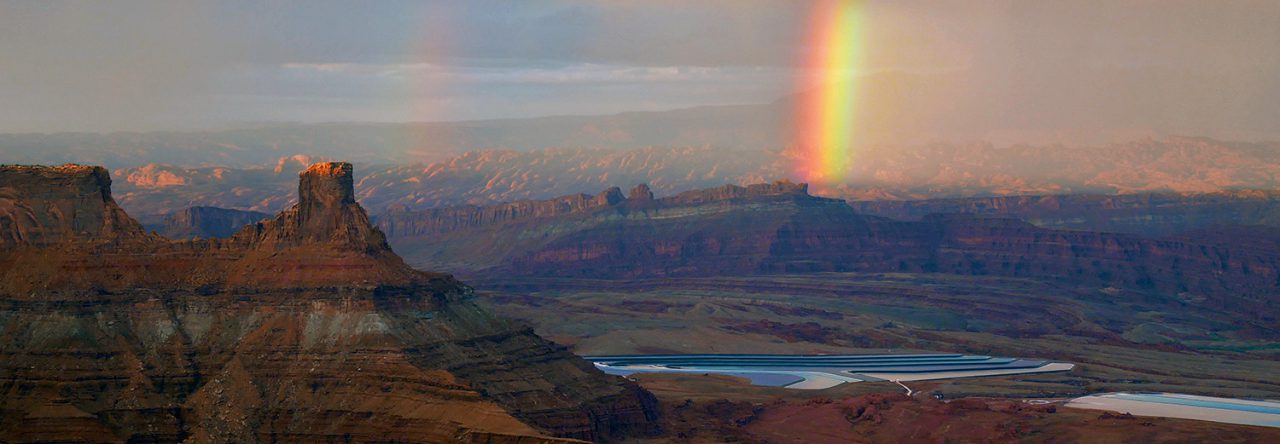
Thanks, Bharat, as usual, you have done full justice to your time out East. Good travelogue, nice pictures too. It would have helped a great deal if you had added a little map of the area so as to give the readers their bearings. Thank God you have managed to escape from the dreaded virus. Perhaps all those visits to the temples pleased Buddha to give you his blessings.!
Take care,
Atul Uncle.
I feel like I’ve just been on a holiday. Much needed. It was a pleasure.